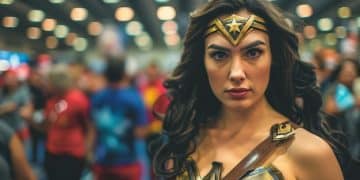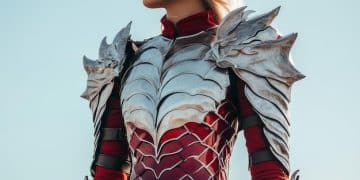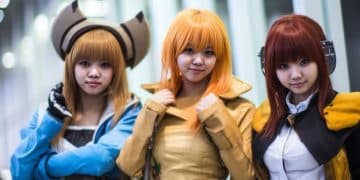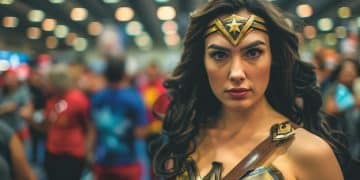Cosplay: Express Your Inner Geek Through Costume and Creativity
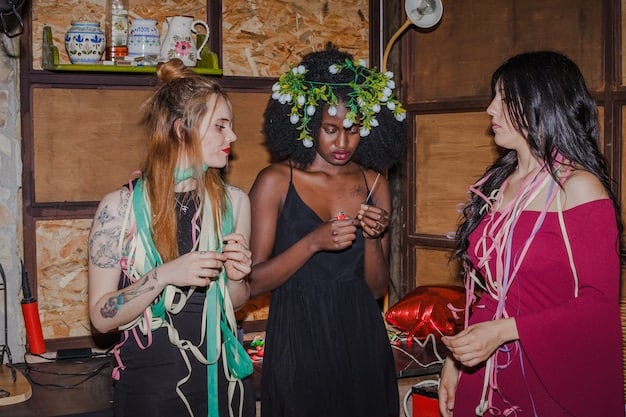
Cosplay, short for “costume play,” is a vibrant subculture where enthusiasts express their passion for characters from various fictional sources by crafting and wearing elaborate costumes, embodying the personalities and appearances of their favorite icons.
Dive into the captivating world of cosplay, a vibrant intersection of creativity, fandom, and self-expression, where enthusiasts transform themselves into their beloved characters.
What is Cosplay? A Gateway to Fandom
Cosplay, a portmanteau of “costume play,” is more than just dressing up; it’s a passionate performance art. It’s about embodying a character you admire, bringing them to life through meticulously crafted costumes, makeup, and even adopting their mannerisms. It offers a unique avenue for self-expression and connection within a community of like-minded fans.
Cosplay is a hobby where individuals create and wear costumes to represent characters from various forms of media. The term itself is a combination of “costume” and “play,” highlighting the performative aspect of the activity. Whether it’s attending conventions, participating in photoshoots, or simply sharing their creations online, cosplayers immerse themselves in the world of their chosen characters.
The Origins of Cosplay
While the modern concept of cosplay is often associated with Japanese anime and manga, its roots can be traced back to science fiction and fantasy conventions in the UnitedSates during the late 1930s. Forrest J Ackerman and Myrtle R. Douglas, often credited as the “first cosplayers,” attended the 1st World Science Fiction Convention in 1939 dressed in futuristic costumes.
The Global Cosplay Phenomenon
Cosplay has evolved into a global phenomenon, with thriving communities in countries around the world. Japan, with its rich culture of anime and manga, is often considered a hub for cosplay, but vibrant scenes can be found in the United States, Europe, South America, and beyond. Each region brings its unique flair and interpretation to the art form.
- Crafting and Construction: Cosplay often involves crafting costumes from scratch, requiring skills in sewing, prop-making, and special effects makeup.
- Performance and Role-Playing: Cosplayers embody their characters through posing, acting, and interacting with other fans, enhancing the immersive experience.
- Community and Connection: Cosplay provides a sense of belonging and camaraderie, fostering friendships and shared experiences among fans.
- Self-Expression and Creativity: Cosplay empowers individuals to express their creativity, showcase their talents, and celebrate their favorite characters in a unique way.
Cosplay is a dynamic and evolving art form that blends creativity, craftsmanship, performance, and community. It’s a way for fans to connect with their favorite characters and stories on a deeper level, while also expressing their individuality and passion.
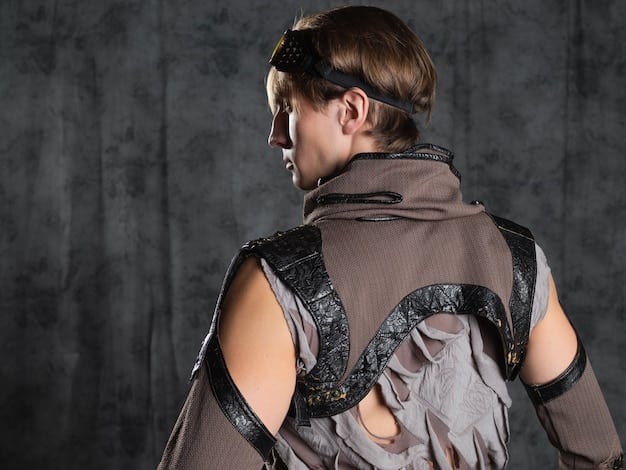
The Crafting Process: From Concept to Creation
Bringing a cosplay to life is a journey, starting with a spark of inspiration and culminating in a tangible representation of a beloved character. The crafting process is where the magic happens, transforming raw materials into stunning costumes and props. It requires a blend of technical skills, artistic vision, and unwavering dedication.
The crafting process of cosplay is a multifaceted undertaking that involves a variety of skills and techniques. From sewing and pattern making to prop construction and wig styling, cosplayers employ a diverse range of methods to bring their visions to life. Let’s explore the key aspects of this creative journey.
Sourcing Inspiration and Materials
The first step in the crafting process is to gather inspiration and plan the costume. This involves researching the character’s design, studying reference images, and determining the materials needed. Cosplayers often utilize online resources, such as character wikis, fan art, and tutorials, to gain a comprehensive understanding of the costume.
Sewing and Garment Construction
For costumes that involve fabric, sewing is an essential skill. Cosplayers must be proficient in pattern making, cutting fabric, and assembling garments. They may use sewing machines, hand-stitching techniques, and various types of fabrics to create the desired look and feel. Attention to detail is crucial, as even small imperfections can detract from the overall appearance of the costume.
- Pattern Creation: Developing accurate patterns is essential for creating well-fitting costumes. Cosplayers may draft their own patterns or adapt existing ones to suit the character’s design.
- Fabric Selection: Choosing the right fabrics is crucial for achieving the desired look, texture, and drape. Cosplayers consider factors such as weight, color, and durability when selecting materials.
- Seam Construction: Strong and durable seams are essential for ensuring that the costume can withstand wear and tear. Cosplayers use various techniques, such as serging and reinforcing seams, to enhance the garment’s longevity.
Crafting is a labor of love that demands patience, perseverance, and a willingness to learn. The rewards, however, are immeasurable. Seeing a cosplay come to life is a source of immense pride and satisfaction, and it’s a testament to the cosplayer’s creativity and dedication.
Cosplay Communities: Finding Your Tribe
Cosplay isn’t just a solo endeavor; it’s a vibrant community where fans connect, collaborate, and celebrate their shared passions. These communities provide a supportive and inclusive environment where cosplayers can learn from each other, share their creations, and forge lasting friendships. They exist both online and offline, offering diverse opportunities for engagement and interaction.
Cosplay communities are the lifeblood of the hobby. They provide a space for cosplayers to connect with like-minded individuals, share their experiences, and support each other’s creative endeavors. These communities can take many forms, from online forums and social media groups to local cosplay clubs and conventions. Let’s explore the various types of cosplay communities and the benefits they offer.
Online Cosplay Communities
The internet has revolutionized the way cosplayers connect and collaborate. Online communities, such as forums, social media groups, and online marketplaces, provide a platform for cosplayers to share their work, ask for advice, and find inspiration. These communities are often organized around specific fandoms or geographical locations, making it easy for cosplayers to find others with shared interests.
Cosplay Conventions and Events
Cosplay conventions are gatherings where cosplayers can showcase their costumes, meet fellow fans, and participate in various activities. These events typically feature cosplay contests, workshops, panels, and vendor booths. Conventions provide a unique opportunity for cosplayers to immerse themselves in the cosplay culture and connect with others in person.
- Cosplay Contests: These competitions provide a platform for cosplayers to showcase their craftsmanship and performance skills. Judges typically evaluate costumes based on accuracy, construction quality, and overall presentation.
- Workshops and Panels: These educational sessions cover a wide range of topics, such as sewing techniques, prop construction, wig styling, and makeup application.
- Photoshoots and Gatherings: Conventions provide opportunities for cosplayers to participate in organized photoshoots and gatherings, allowing them to capture their costumes in professional settings and connect with other fans of the same series.
Whether online or offline, cosplay communities offer a sense of belonging and support. They provide a space for cosplayers to express their creativity, share their passion, and celebrate their love for fandom.
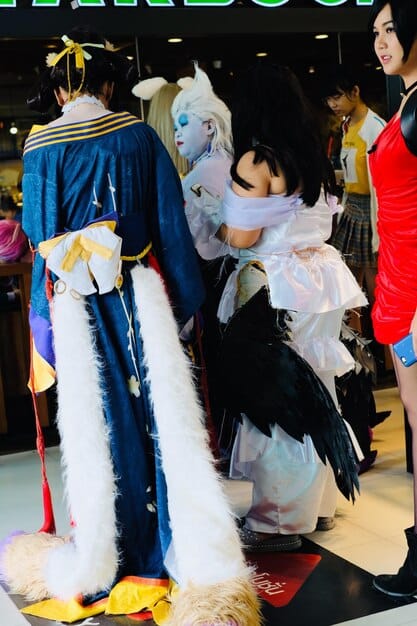
Cosplay Etiquette: Respect and Inclusivity
Cosplay, like any community-driven activity, thrives on respect, inclusivity, and understanding. Cosplay etiquette ensures that everyone feels welcome, safe, and appreciated. It’s about creating a positive and supportive environment where cosplayers can express themselves freely and celebrate their shared passion.
Cosplay etiquette encompasses a set of guidelines and best practices that promote respect, inclusivity, and safety within the cosplay community. Adhering to these principles ensures a positive and enjoyable experience for all participants. Let’s explore some key aspects of cosplay etiquette.
Respecting Personal Boundaries
One of the most important aspects of cosplay etiquette is respecting personal boundaries. This includes asking for permission before taking photos of cosplayers, avoiding unsolicited advice or criticism, and refraining from touching or grabbing cosplayers without their consent. It’s essential to remember that cosplayers are individuals who deserve to be treated with respect and dignity.
Promoting Inclusivity and Acceptance
Cosplay is for everyone, regardless of their age, gender, race, body type, or skill level. It’s important to create a welcoming and inclusive environment where all cosplayers feel comfortable expressing themselves. This means avoiding judgmental comments, promoting body positivity, and celebrating diversity within the community.
Practicing Safe and Responsible Cosplay
Cosplay can involve certain risks, such as wearing uncomfortable costumes, handling sharp props, or spending long hours in crowded spaces. It’s important to prioritize safety and take precautions to minimize potential harm. This includes staying hydrated, taking breaks when needed, and being aware of your surroundings.
- Costume Comfort: Choose costumes that are comfortable to wear and move in. Avoid costumes that restrict breathing or create excessive heat.
- Prop Safety: Handle props responsibly and be mindful of others in crowded areas. Avoid using sharp or dangerous props that could cause injury.
- Consent and Boundaries: Always ask for consent before taking photos of cosplayers and respect their boundaries. Avoid touching or grabbing cosplayers without their permission.
By adhering to these principles, cosplayers can create a positive and inclusive environment where everyone feels welcome, respected, and empowered to express their creativity.
The Future of Cosplay: Innovation and Evolution
Cosplay is a constantly evolving art form, driven by technological advancements, creative innovation, and the ever-changing landscape of fandom. As new materials, techniques, and platforms emerge, cosplayers are pushing the boundaries of what’s possible, creating ever more intricate and immersive costumes. The future of cosplay promises to be even more exciting and dynamic than its past.
The future of cosplay is ripe with possibilities, fueled by technological advancements, evolving trends, and the boundless creativity of cosplayers. As new tools and techniques become available, cosplayers will continue to push the boundaries of the art form, creating ever more impressive and immersive costumes. Let’s explore some of the key trends and innovations shaping the future of cosplay.
Technological Advancements in Cosplay
Technology is playing an increasingly important role in cosplay. 3D printing is enabling cosplayers to create intricate props and armor pieces with unprecedented precision. Wearable electronics are adding dynamic lighting and sound effects to costumes. Augmented reality is blurring the lines between the real world and the virtual world, allowing cosplayers to create interactive and immersive experiences.
Sustainability in Cosplay
As awareness of environmental issues grows, cosplayers are increasingly seeking sustainable and eco-friendly materials and techniques. This includes using recycled fabrics, repurposing existing materials, and adopting environmentally friendly crafting methods. Sustainability is becoming not just a trend, but a core value within the cosplay community.
- Sustainable Materials: Explore eco-friendly fabrics, such as organic cotton, bamboo, and hemp. Repurpose existing materials, such as old clothing and household items, to create unique and sustainable costumes.
- Eco-Friendly Techniques: Adopt environmentally friendly crafting methods, such as using non-toxic paints and glues. Minimize waste by recycling scraps and properly disposing of materials.
- Community Initiatives: Participate in community initiatives that promote sustainability in cosplay, such as clothing swaps and repair workshops.
The future of cosplay is bright, driven by technological innovation, creative ingenuity, and a growing commitment to sustainability. As cosplayers continue to explore new frontiers, the art form will evolve in exciting and unexpected ways.
Cosplay as a Form of Self-Discovery
Beyond the spectacle of costumes and conventions, cosplay can be a powerful journey of self-discovery. It allows individuals to explore different facets of their personality, connect with their emotions, and gain confidence in their own skin. By embodying characters they admire, cosplayers can tap into parts of themselves they never knew existed.
Cosplay can serve as a vehicle for self-discovery, allowing individuals to explore their identities, express their emotions, and gain confidence in their own skin. By embodying characters they admire, cosplayers can tap into parts of themselves they never knew existed. Let’s explore the transformative power of cosplay.
Embracing Different Personalities
Cosplay allows individuals to step outside of their comfort zones and embrace different personalities. By embodying characters with traits they admire, cosplayers can experiment with new ways of thinking, feeling, and behaving. This can lead to a greater understanding of oneself and the world around them.
Connecting with Emotions
Cosplay can provide a safe space for individuals to connect with their emotions. By portraying characters who have experienced similar feelings, cosplayers can process their own emotions in a healthy and constructive way. This can be particularly beneficial for individuals who struggle with expressing their emotions in everyday life.
- Emotional Expression: Use cosplay as a tool for expressing emotions that may be difficult to articulate otherwise. Choose characters who resonate with your own emotional experiences.
- Role-Playing and Empathy: Explore the perspectives of different characters and develop empathy for others. Consider the motivations and challenges faced by the characters you portray.
- Self-Reflection and Growth: Reflect on your experiences as a cosplayer and consider how they have impacted your personal growth. Identify areas where you have gained confidence, resilience, or self-awareness.
Cosplay is more than just dressing up; it’s a transformative journey of self-discovery. By embracing different personalities, connecting with emotions, and building confidence, cosplayers can unlock their full potential and live more authentic lives.
| Key Aspect | Brief Description |
|---|---|
| 🎭 Definition | Dressing up as characters from various media. |
| 🧵 Crafting | Skills in sewing, prop-making, and makeup. |
| 🤝 Community | Connecting with fans and sharing creations. |
| 🌟 Self-Expression | Expressing creativity and celebrating fandom. |
Frequently Asked Questions
▼
Cosplay is a combination of the words “costume” and “play”. It’s a hobby where participants wear costumes and accessories to represent a specific character.
▼
You can showcase your cosplay at conventions, photoshoots, online platforms, and social media. Each offers a unique way to share your work with the community.
▼
Cosplay etiquette includes respecting personal boundaries, promoting inclusivity, and practicing safe behavior. It ensures a positive and enjoyable experience for everyone involved.
▼
Start by researching the character, gathering materials, and practicing basic crafting skills. Online tutorials and community support can offer guidance.
▼
Common skills include sewing, prop-making, makeup, wig styling, and performance. Each skill contributes to creating an authentic and immersive character representation.
Conclusion
Cosplay provides an avenue for creativity and community. By embracing your favorite characters, honing your craft, and connecting with fellow enthusiasts, you unlock a world of self-expression, friendship, and fun. Dive in, explore your imagination, and let the art of cosplay bring joy and inspiration to your life.

